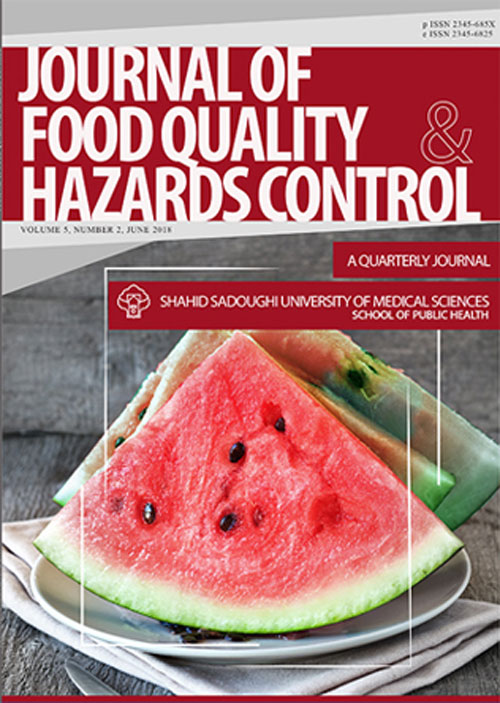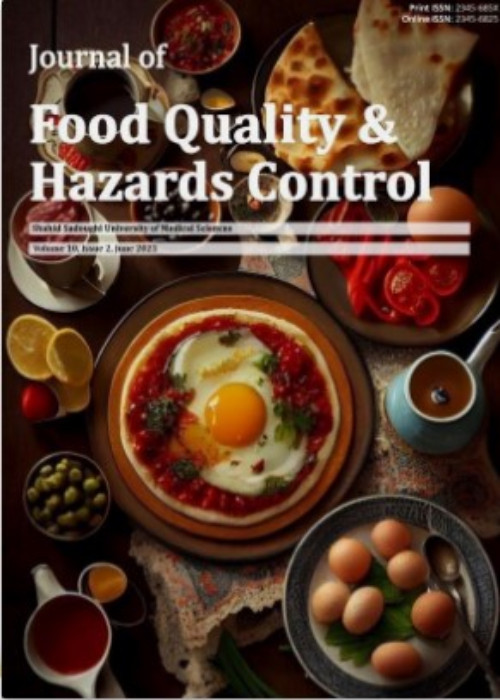فهرست مطالب

Journal of Food Quality and Hazards Control
Volume:5 Issue: 2, Jun 2018
- تاریخ انتشار: 1397/04/20
- تعداد عناوین: 8
-
-
Pages 41-48BackgroundPlant-derived Essential Oils (EOs) have shown remarkable antimicrobial activity against spoilage and pathogenic microorganisms isolated from food products. The objective of the current study was to determine in vitro antimicrobial effects of selected EOs against these microorganisms.MethodsAntimicrobial activity of EOs against food-borne and spoilage microorganisms was screened by disk diffusion assay; then, the Minimum Inhibitory Concentration (MIC) and Minimal Bactericidal Concentration (MBC) were determined. Statistical analysis was done using SPSS 23.0 software for Windows.ResultsOregano and thyme EOs showed the highest antimicrobial activity and the lowest MICs, while anise, fennel, garlic, and ginger showed a lower activity with significant differences (pConclusionThe use of the analyzed EOs may be interesting to food processors because of their antimicrobial properties. However, it is necessary to test their use in food products and gauge their sensory implications.Keywords: Oils, Volatile, Plants, Anti, Bacterial Agents, Food Microbiology
-
Characterization of Phenolic Profile and Antioxidant Potential of Some Algerian Olive Oils CultivarsPages 49-53BackgroundOlive oil is a source of antioxidants and poses positive effects on human health. The objective of this study was firstly to identify and quantify the phenolics of some Algerian olive oils; secondly, the antioxidant activity of the samples was assessed.MethodsThe virgin olive oils used in this study were derived from three Algerian cultivars, including Azeradj, Bouchouk, and Chemlal. After preparation of the samples, the phenolic, ortho-diphenol and flavonol contents in addition to phenolic profile were determined. Also, antioxidant capacity, reducing power, and 1,1-diphenyl-2-picrylhydrazyl (DPPH) radical scavenging activity values were analyzed. Statistical analysis of the data was done with Statistica 5.5 Fr.ResultsThe phenolic contents of analyzed olive oils showed significant differences (pConclusionBoth Chemlal and Azeradj Algerian olive oil cultivars can be considered as appropriate sources of bioactive phytochemicals, which play a major role in human health as free radical scavenger and can replace synthetic antioxidant in the food products.Keywords: Olive Oil, Phenols, Antioxidants
-
Pages 54-60BackgroundNowadays, colostrum has been known as a considerable and valuable by-product of large-scale dairy production in the world. The main objective of this study was to evaluate the effects of pasteurization, spray-drying and freeze-drying methods on bacterial loads and Immunoglobulin G (IgG) level of bovine colostrums.MethodsColostrum samples were collected from the first milking postpartum of Iranian Holstein dairy cattle farms. The samples were treated by pasteurization (60 °C for 30 min and 55 °C for 60 min), spray-drying and freeze-drying methods. Standard Plate Counts (SPC), Escherichia coli count, and Total Coliform Count (TCC) were analyzed at days 1, 10, 20, and 30 of storage. Also, IgG level were assessed at the end of 30-day storage. Statistical analysis was performed using SPSS 17.0 (Chicago, IL, USA) software.ResultsAlthough all four treatments showed direct impact on reduction of SPC, TCC, and E. coli count in colostrum stored at 1, 10, 20, and 30 days, but the spray-drying and freeze-drying methods were significantly (pConclusionConsidering the obtained results, it seems that freeze-drying and spray-drying methods could be more effective than pasteurization ones to enhance quality and shelf life of bovine colostrum for a long time.Keywords: Colostrum, Immunoglobulin G, Food Microbiology, Food Preservation
-
Pages 61-71BackgroundEssential Oils (EOs) of spices may serve as a potential source of antibacterial and antioxidant agents due to the presence of a diverse group of phytochemicals. In the present investigation, an attempt has been made to seek EOs from five commonly used spices that have both strong antibacterial and antioxidant potential to shed some light on these important aspects.MethodsIn vitro antibacterial efficacy of black cumin, black pepper, cinnamon, clove, and nutmeg EOs were evaluated against some food-borne bacteria using agar well diffusion, microbroth dilution, and time-kill assay methods. Antioxidant potential was evaluated by 1,1-diphenyl-2-picrylhydrazyl (DPPH) radical scavenging, β-carotene linoleic acid bleaching and Fe2 ion chelating methods. Chemical characterization of EO components was performed by Gas Chromatography-Mass Spectrometry (GC-MS). Statistical analysis of data was performed using SPSS software, version 18.0.ResultsBlack pepper, cinnamon, and clove EOs had significantly (pConclusionThe results provide evidence that EOs of clove, black pepper, and cinnamon may serve as effective natural preservatives in the food industry. Further studies are needed for their plausible applications in the food industry.Keywords: Spices, Oils, Volatile, Antioxidants, Anti, Bacterial Agents
-
Pages 72-76BackgroundStaphylococcus aureus, a Gram-positive bacterium, is the most prevalent food-borne pathogen in most regions of the world. The current study was carried out with the aim of S. aureus isolation from shrimps sold in Tehran, Iran. Furthermore, the genes of mecA as indicator of methicillin-resistant S. aureus, sea, seb, and tsst encoding enterotoxins were studied in the S. aureus isolates.MethodsTotally, 150 fresh and 150 frozen shrimp samples were collected from seafood retailers in Tehran. Isolation of S. aureus from the samples was carried out using conventional methods. The target genes were identified using polymerase chain reaction technique. Data were statistically analyzed using SPSS v. 11.5 software.ResultsOut of 150 fresh and 150 frozen samples, 84 samples (28%) were contaminated with S. aureus. The contamination rate in fresh samples (22%) was significantly (pConclusionHigh prevalence rates of enterotoxigenic and also antibiotic resistance genes in S. aureus isolated from shrimp samples in the current study highlighted worries about risk of staphylococcal food poisoning in Iranian shrimp consumers.Keywords: Staphylococcus aureus, Seafood, Polymerase Chain Reaction
-
Pages 77-80BackgroundSo far, there is paucity of information about quality of breads available in Ethiopian bakeries. The aim of this study was to assess the proximate composition and some selected nutrient composition of wheat breads baked in Bahir Dar City, Ethiopia.MethodsTotally, 54 fresh loaves of wheat bread were randomly taken from 18 bakeries (three from each one) in Bahir Dar City, Ethiopia. Then, the proximate composition and mineral contents of the samples were determined.ResultsThe results of the analysis revealed that the proximate compositions were ranged from 12.16 to 28.38%, 0.77 to 2.33%, 0.41 to 1.87%, 0.13 to 1.36%, 8.01 to 14.34%, and 54.83 to 76.99% for moisture, total ash, crude fat, dietary fiber, crude protein, and carbohydrate, respectively. In addition, the level of calcium, iron, and zinc were ranged from 11.1 to 22.0, 1.2 to 12.5, and 0.7 to 2.1 mg/100 g, respectively.ConclusionSome wheat bread sampled from Bahir Dar City did not meet the bread quality standards parameters. So, it is necessary to design supervision mechanisms to enforce the local bakeries to select the suitable ingredients and produce bread with the required composition.Keywords: Bread, Food Quality, Food Analysis, Ethiopia


